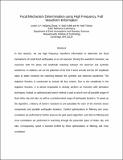Focal Mechanism Determination using High Frequency, Full Waveform Information
Author(s)
Li, Junlun; Zhang, Haijiang; Kuleli, Huseyin Sadi; Toksoz, M. Nafi
DownloadJunlun_2009.pdf (576.2Kb)
Other Contributors
Massachusetts Institute of Technology. Earth Resources Laboratory
Metadata
Show full item recordAbstract
In this research, we use high frequency waveform information to determine the focal mechanisms of small local earthquakes at an oil reservoir. During the waveform inversion, we maximize both the phase and amplitude matching between the observed and synthetic waveforms. In addition, we use the polarities of the first P-wave arrivals and the S/P amplitude ratios to better constrain the matching between the synthetic and observed waveforms. The objective function is constructed to include all four criteria. Due to the complexity in the objective function, it is almost impossible to directly perform an inversion with derivative techniques. Instead, an optimized grid search method is used to search over all possible ranges of fault strike, dip and rake, as well as a predetermined range of earthquake locations. To speed up the algorithm, a library of Green‟s functions is pre-calculated for each of the moment tensor components and possible earthquake locations. Careful optimizations in filtering and cross-correlation are performed to further improve the grid search algorithm, such that no filtering and cross correlations are performed in searching through the parameter space of strike, dip, and rake. Consequently, speed is boosted tenfold by these optimizations in filtering and cross correlation. We apply the new method to induced seismic events in an oil reservoir. Satisfactory matching between synthetic and observed seismograms is obtained, as well as reasonable focal mechanisms, considering the local geological structure and possible causes for induced seismicity.
Date issued
2009Publisher
Massachusetts Institute of Technology. Earth Resources Laboratory
Series/Report no.
Earth Resources Laboratory Industry Consortia Annual Report;2009-06
Keywords
Microseismic, Inversion